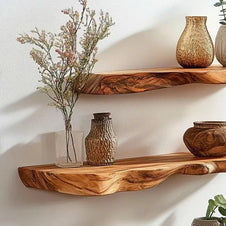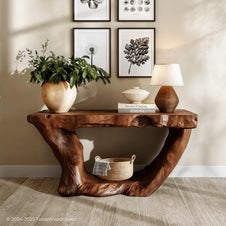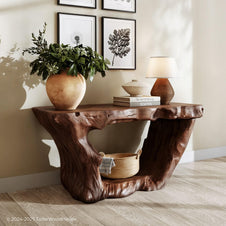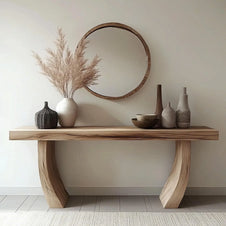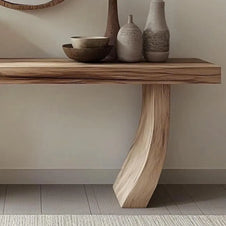Learning how to join a corner shelf correctly is key to both strength and style. A poorly joined shelf may sag, shift, or even collapse under pressure—especially in high-traffic areas like kitchens, bathrooms, or living rooms. But done right? You’ll have a rock-solid corner unit that looks built-in, not bolted-on.
This guide is here to help you master the craft. Whether you're building a floating corner shelf, joining two flat boards into an L-shape, or reinforcing a freestanding unit, we'll walk you through exactly how to join a corner shelf like a pro.
1. Understanding Shelf Types and Join Configurations
Before diving into techniques, know what kind of corner shelf you're working with. The method for how to join a corner shelf depends on the design:
-
Wall-mounted L-shape: Two boards meeting at 90° against two walls
-
Freestanding corner shelf: Trapezoid or triangle structure
-
Floating shelf: Hidden brackets or dowels inside the wood
-
Tree bookshelf or decorative shelf: Irregular joinery points
 We’ll cover the best joint types for each setup of corner tree bookshelf.
We’ll cover the best joint types for each setup of corner tree bookshelf.
2. Measuring and Marking Your Join Area
Accurate measuring is step one in how to join a corner shelf. Grab a tape measure, pencil, T-square, and level. Here’s what to do:
-
Measure each wall’s length
-
Determine the desired shelf depth
-
Use a framing square to mark 90° angles on each board
-
Check diagonals to verify squareness
Use painter’s tape to create a mock-up on your wall. This will help you visualize your finished product and prevent mistakes later in the process.
 Pro tip: leave 1/8" space between shelf ends and the wall for expansion of corner tree bookshelf.
Pro tip: leave 1/8" space between shelf ends and the wall for expansion of corner tree bookshelf.
3. Choosing the Right Joinery Method
Once your materials are measured and cut, it’s time to choose a joinery technique. This step is critical in mastering how to join a corner shelf. Your options include:
-
Butt joint with screws: Simple and fast, but requires brackets or dowels for strength.
-
Miter joint: A 45° angle cut on both boards; creates a clean corner but needs glue and reinforcement.
-
Pocket hole joinery: Uses a jig to drill angled holes; perfect for hidden, tight joins.
-
Biscuit joint: Slots cut into each board that accept thin wooden 'biscuits' with glue; ideal for wide shelves.
-
Dowel joint: Wooden pegs inserted into aligned holes; strong and relatively easy to align.
For floating or wall-mounted shelves, consider metal bracket support inside or behind the wood. Floating shelves often rely on dowels or rods drilled into both the wall and the shelf.
If your shelf is a trapezoid or fits into a three-wall corner, you might use French cleats or adjustable L-brackets instead of joining wood to wood directly. Knowing how to join a corner shelf in these more advanced scenarios depends on picking a joinery that suits both form and function.
4. Prepping the Wood Surfaces
Clean, smooth surfaces bond best. Here’s how to prep before joining:
-
Sand all edges where boards will meet using 120–220 grit sandpaper.
-
Wipe dust with a damp cloth.
-
Apply painter’s tape around the join areas to avoid glue spills on visible grain.
-
Mark each part with pencil (label A1, A2, B1, etc.) to track orientation.
If using hardwoods like oak or maple, pre-drill holes for screws or dowels to avoid splitting. This simple prep is often overlooked but vital when learning how to join a corner shelf securely and cleanly.
Let your wood acclimate in the room it will be installed in—this reduces warping post-installation.
5. Gluing and Clamping Techniques
Wood glue is your best friend in making your join tight and lasting. Follow these steps:
-
Apply an even layer of wood glue to both surfaces.
-
Use a brush or finger to spread the glue into pores.
-
Clamp the joint tightly using corner clamps or bar clamps.
-
Wipe off any squeezed-out glue with a damp cloth immediately.
Let the joint sit for at least 30 minutes under pressure; full cure takes 24 hours. During this time, avoid moving or installing the shelf.
Knowing how to join a corner shelf with glue and clamps is about patience and pressure. Too little pressure = weak join. Too much = squeezed glue = weak join again.
Check for squareness again once clamped. An off-angle shelf is not only ugly—it’s unsafe.
6. Reinforcing and Securing the Joint
Once your joint is dry, it's time to reinforce. This step is especially critical for long-term strength and weight support. Here are your options:
-
Corner braces: Install small metal L-brackets under the shelf where boards meet. These are cheap, discreet, and easy to screw into place.
-
Hidden cleats or shelf pins: If you're doing a floating style, internal wooden cleats or metal pins can help bear vertical weight without showing.
-
Nail or screw plates: Metal plates with screw holes can be attached on the underside of the join, especially helpful for utility shelves.
Some DIYers opt for wood biscuits or dowels again after the initial glue join for an extra level of strength. If your shelf will hold heavy items like books, plants, or electronics, reinforcements are non-negotiable. Reinforcing is what turns your basic glue-up into a solid solution—and truly answers how to join a corner shelf that lasts.

Paint or stain any visible hardware to match the shelf color for a seamless corner tree bookshelf finish.
7. Mounting and Leveling the Shelf
Even a perfectly joined corner shelf won’t function if it's not level on the wall. Here’s how to ensure a smooth install:
-
Find studs with a stud finder and mark them with painter’s tape.
-
Use a level to draw horizontal and vertical lines as mounting guides.
-
Pre-drill holes for your wall anchors or shelf brackets.
-
Secure the shelf by screwing through the back into studs or anchors.
If your shelf design uses hidden mounting hardware like floating rods or cleats, ensure those are perfectly aligned on both walls before attaching the shelf itself.
Add finishing touches: wood filler over screw heads, color-matched paint or stain, and a final protective topcoat if needed.

This final step locks in all your hard work. And now you truly know how to join a corner shelf and install it like a pro.
Conclusion: From Two Boards to One Functional Design
By now, you’ve learned every stage of how to join a corner shelf—from choosing joinery to finishing and mounting. This DIY isn't just about joining wood. It's about creating a cohesive, custom solution that blends beauty and utility.
Take your time, measure twice, and don’t rush the glue-up. The reward is a sturdy, visually seamless corner shelf you can rely on for years.
So whether you’re upgrading your home office, adding charm to a reading nook, or making use of an awkward wall corner, you now have all the tools and knowledge to do it right. Happy building!


